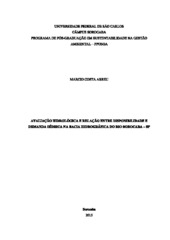| dc.contributor.author | Abreu, Marcio Costa | |
| dc.date.accessioned | 2017-02-13T13:07:45Z | |
| dc.date.available | 2017-02-13T13:07:45Z | |
| dc.date.issued | 2015-11-03 | |
| dc.identifier.citation | ABREU, Marcio Costa. Avaliação hidrológica e relação entre disponibilidade e demanda hídrica na Bacia hidrográfica do Rio Sorocaba. 2015. Dissertação (Mestrado em Sustentabilidade na Gestão Ambiental) – Universidade Federal de São Carlos, Sorocaba, 2015. Disponível em: https://repositorio.ufscar.br/handle/ufscar/8511. | * |
| dc.identifier.uri | https://repositorio.ufscar.br/handle/ufscar/8511 | |
| dc.description.abstract | This study aimed to contribute to the understanding of the dynamics of water resources in the watershed of Sorocaba river and establish relationships between availability and water demand. Initially it was proposed a quantitative model of how to distribute the water in the different stages of the water cycle, from the moment of the rains, to flow to your river mouth, considering the intermediate steps between these two events, including human interventions represented by withdrawals of water from springs. For it was carried out the survey and analysis of hydrological data available and estimated those without measurements through the water balance. Set up for the series evaluated the climatological normal temperatures and rainfall and the average flow rate in river mouth, ie the watercourse that is base level of the watershed. The following parameters were estimated: potential and real evapotranspiration, surplus and water deficit. The average rainfall in the basin for the period 2006-2012 was 1,337 mm.year-1 , the average annual temperature 21.2°C, the ETP and ETR 1,011 mm.year-1 and 999 mm.year-1 , respectively, the water surplus 338 mm.year-1 , the average flow in river mouth 360 mm.year-1 and the flow derived and actually consumed by the users of 16 mm.year-1 . The water availability was adopted as the flow with 95% permanence (Q95%), estimated at 24.1 m3 .s-1 and the demands were obtained based on data from granting processes and by other methodologies, enabling a comparison between the results. Demands for major consumptive uses identified in the watershed were calculated with the following results: human supply 6.20 m 3 .s-1 ; industrial 1.83 m 3 .s-1 ; irrigation 3.59 m 3 .s-1 ; and animal consumption 0.24 m 3 .s-1 . The relationship between availability versus demand was considered and the results allowed indicate that the current situation of water resources across its use is very critical. | eng |
| dc.description.sponsorship | Não recebi financiamento | por |
| dc.language.iso | por | por |
| dc.publisher | Universidade Federal de São Carlos | por |
| dc.rights.uri | Acesso aberto | por |
| dc.subject | Recursos hídricos - desenvolvimento | por |
| dc.subject | Balanço hidrológico | por |
| dc.subject | Water resources development | eng |
| dc.subject | Water balance (Hidrology) | eng |
| dc.subject | Water resources management | eng |
| dc.subject | water escassez | por |
| dc.title | Avaliação hidrológica e relação entre disponibilidade e demanda hídrica na Bacia hidrográfica do Rio Sorocaba | por |
| dc.title.alternative | Hydrologic evaluation and relationship between water availability and demand in the Sorocaba river watershed - SP | eng |
| dc.type | Dissertação | por |
| dc.contributor.advisor1 | Tonello, Kelly Cristina | |
| dc.contributor.advisor1Lattes | http://lattes.cnpq.br/3844965971290638 | por |
| dc.description.resumo | Este trabalho teve como objetivo contribuir para o entendimento da dinâmica dos recursos hídricos na bacia do rio Sorocaba e estabelecer relações entre a disponibilidade e as demandas. Inicialmente foi proposto um modelo quantitativo de como se distribui a água nas diferentes fases do ciclo hidrológico, desde o momento das chuvas, até a vazão no seu exutório, considerando-se as etapas intermediárias entre esses dois eventos (entrada e saída), incluindo as intervenções antrópicas representadas pelas retiradas de água dos mananciais. Para isso foi realizado o levantamento e a análise dos dados hidrometeorológicos disponíveis e estimados aqueles sem aferições, por meio do balanço hídrico. Definiu-se para a série histórica avaliada as normais climatológicas de temperatura e chuvas e a vazão média no exutório da bacia, ou seja, do curso d’água que representa o seu nível de base. Foram estimados os seguintes parâmetros: evapotranspiração potencial e real, o excedente e a deficiência hídrica. A chuva média na bacia para o período de 2006 a 2012 foi de 1.337 mm.ano-1 , a temperatura média anual 21,2 °C, a ETP e a ETR 1.011 mm.ano-1 e 999 mm.ano-1 , respectivamente, o excedente hídrico 338 mm.ano-1 , a vazão média no exutório 360 mm.ano-1 e a vazão derivada e efetivamente consumida pelos usuários de 16 mm.ano-1 . A disponibilidade hídrica foi adotada como a vazão com permanência de 95% (Q95%), calculada em 24,1 m 3 .s-1 e as demandas foram obtidas com base nos dados dos processos de outorga e por outras metodologias, permitindo uma comparação entre os resultados. Foram calculadas as demandas para os principais usos consuntivos identificados na bacia, com os seguintes resultados: abastecimento humano 6,20 m 3 .s-1 ; industrial 1,83 m 3 .s-1 ; irrigação 3,59 m 3 .s-1 ; e dessedentação animal 0,24 m 3 .s-1 . A relação entre disponibilidade versus demandas foi considerada e o resultado permitiu indicar que a atual situação dos recursos hídricos frente à sua utilização é muito crítica. | por |
| dc.publisher.initials | UFSCar | por |
| dc.publisher.program | Programa de Pós-Graduação em Sustentabilidade na Gestão Ambiental - PPGSGA-So | por |
| dc.subject.cnpq | CIENCIAS AGRARIAS::RECURSOS FLORESTAIS E ENGENHARIA FLORESTAL::CONSERVACAO DA NATUREZA::CONSERVACAO DE BACIAS HIDROGRAFICAS | por |
| dc.ufscar.embargo | Online | por |
| dc.publisher.address | Câmpus Sorocaba | por |
| dc.contributor.authorlattes | http://lattes.cnpq.br/6597291397353609 | por |
